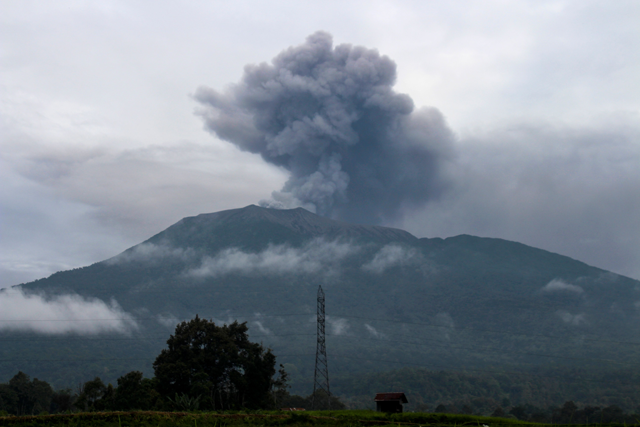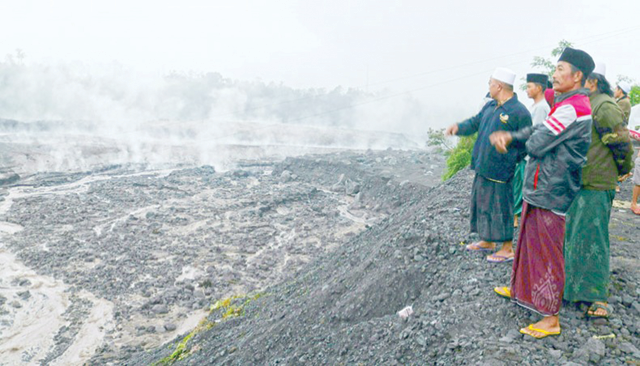You are here
At least 31 feared dead near peak of Japanese volcano
By Reuters - Sep 28,2014 - Last updated at Sep 28,2014

TOKYO — Thirty-one people were presumed dead on Sunday near the peak of a Japanese volcano that erupted a day earlier, catching hundreds of hikers unawares as it belched out clouds of rock and ash.
The deaths on Mount Ontake, 200km west of Tokyo, were the first from a Japanese volcanic eruption since 1991.
Police said the 31 were found in "cardio-pulmonary arrest", but declined to confirm their deaths pending a formal examination, as per Japanese custom. Public broadcaster NHK and the Kyodo news agency later reported that four, all male, had been confirmed dead.
An official in the area said rescue efforts had been called off due to rising levels of toxic gas near the peak, as well as approaching nightfall.
Hundreds of people, including children, were stranded on the mountain, a popular hiking site, after it erupted without warning on Saturday, sending ash pouring down the slope for more than 3km.
Most made their way down later on Saturday but about 40 spent the night near the 3,067-metre peak. Some wrapped themselves in blankets and huddled in the basement of buildings.
"The roof on the mountain lodge was destroyed by falling rock, so we had to take refuge below the building," one told NHK national television. "That's how bad it was."
More than 40 people were injured, several with broken bones.
Earlier, the Fire and Disaster Management Agency had said authorities were trying to confirm the whereabouts of 45 people.
It was not clear whether those 45 included the 31 people found in cardio-pulmonary arrest.
The volcano was still erupting on Sunday, pouring smoke and ash hundreds of metres into the sky. Ash was found on cars as far as 80km away.
Volcanoes erupt periodically in Japan, one of the world's most seismically active nations, but there have been no fatalities since 1991, when 43 people died in a pyroclastic flow, a superheated current of gas and rock, at Mount Unzen in the southwest of the country.
Ontake, Japan's second-highest volcano, last erupted seven years ago. Its last major eruption was in 1979.
Satoshi Saito, a 52-year-old hiker who climbed Ontake on Saturday and descended less than an hour before the eruption, said the weather was good and the mountain, known for its autumn foliage, was crowded with people carrying cameras.
"There were no earthquakes or strange smells on the mountain when I was there," Saito, who usually climbs Ontake several times a year, told Reuters. He also said there were no warnings of possible eruptions posted on the trail.
"But a man who runs a hotel near the mountain told me that the number of small earthquakes had risen these past two months, and everyone thought it was weird," Saito said.
Enveloping blackness
Video footage on the Internet showed huge grey clouds boiling towards climbers at the peak and people scrambling to descend as blackness enveloped them. NHK footage showed windows in a mountain lodge darkening and people screaming as heavy objects pelted the roof.
"All of a sudden ash piled up so quickly that we couldn't even open the door," Shuichi Mukai, who worked in a mountain lodge just below the peak, told Reuters. The building quickly filled with hikers taking refuge.
"We were really packed in, maybe 150 people. There were some children crying, but most people were calm. We waited there in hard hats until they told us it was safe to come down."
Flights at Tokyo's Haneda Airport suffered delays on Saturday as planes changed routes to avoid the volcano, but were mostly back to normal by Sunday, an airport spokeswoman said.
Japan lies on the "Ring of Fire", a horseshoe-shaped band of fault lines and volcanoes circling the edges of the Pacific Ocean, and is home to 110 active volcanoes.
One of these, Sakurajima at the southern end of the western island of Kyushu, is 50km from Kyushu Electric Power's Sendai nuclear plant, which was approved to restart by Japan's nuclear regulator earlier in September.
The Nuclear Regulation Authority has said the chance of volcanic activity during the Sendai plant's lifespan is negligible, even though five giant calderas, crater-like depressions formed by past eruptions, are also nearby.
Kyushu Electric has said it will install new monitoring equipment around nearby calderas and develop plans to remove highly radioactive fuel to a safer site if the threat of an eruption is detected.
There are no nuclear plants near Ontake.
An official at the volcano division of the Japan Meteorological Agency said that, while there had been a rising number of small earthquakes detected at Ontake since September 10, the eruption could not have been predicted easily.
"There were no other signs of an imminent eruption, such as earth movements or changes on the mountain's surface," the official told Reuters. "With only the earthquakes, we couldn't really say this would lead to an eruption."
Related Articles
TOKYO — Dozens of people were urged to evacuate their homes after a fiery volcanic eruption in southern Japan on Sunday as the national weat
PADANG, Indonesia — Eleven hikers were found dead Monday and another 12 were missing after a volcano erupted in Indonesia, with rescuers rac
LUMAJANG, Indonesia — Indonesia's Mount Semeru erupted on Sunday spewing hot ash clouds a mile high and rivers of lava down its side while s


















